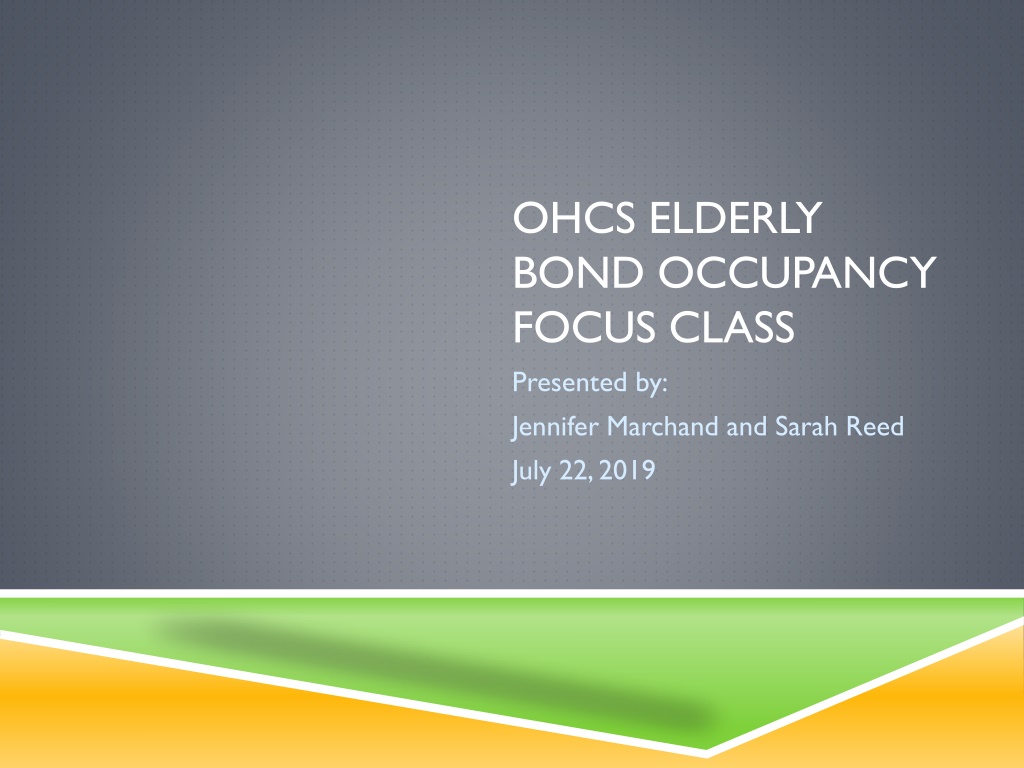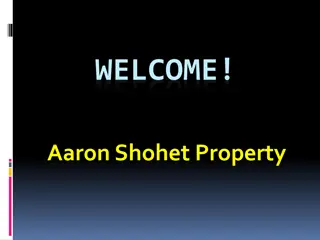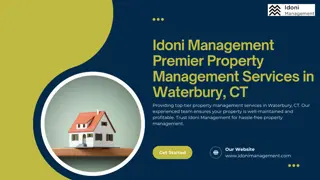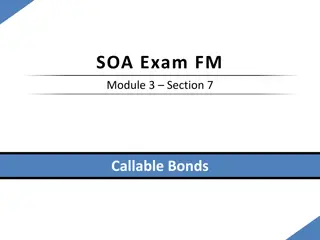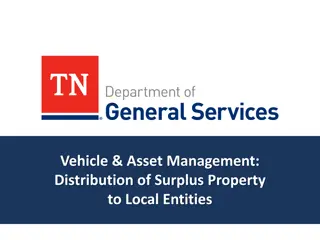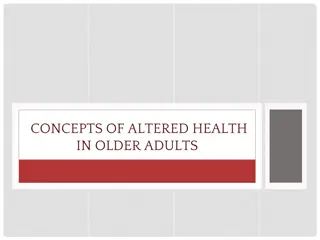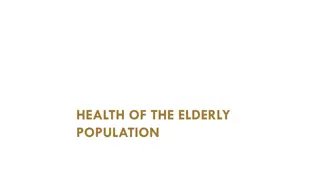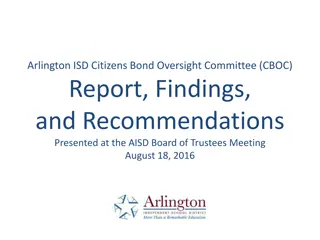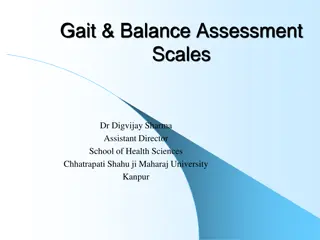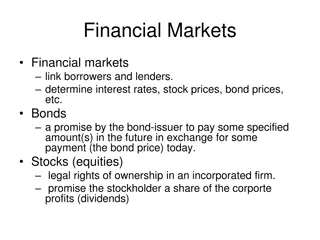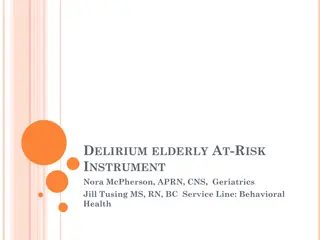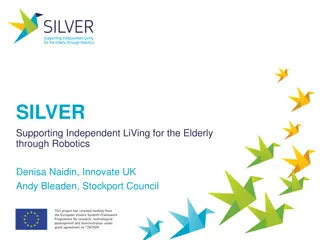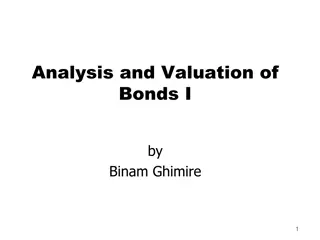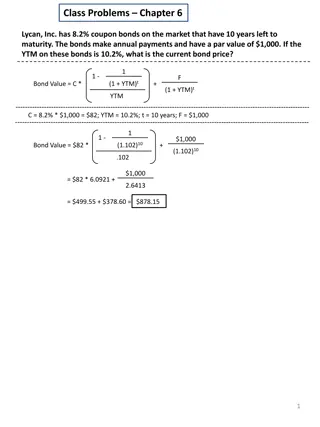Understanding Elderly Bond Property Compliance in Oregon
Oregon Housing and Community Services (OHCS) issues tax-exempt bonds for the development of housing for low-income elderly and disabled individuals. Bond properties must meet program requirements to maintain compliance and avoid risks to bond series and credit ratings. OHCS plays a vital role in monitoring compliance over a minimum of 30 years post-funding.
Download Presentation

Please find below an Image/Link to download the presentation.
The content on the website is provided AS IS for your information and personal use only. It may not be sold, licensed, or shared on other websites without obtaining consent from the author. Download presentation by click this link. If you encounter any issues during the download, it is possible that the publisher has removed the file from their server.
E N D
Presentation Transcript
OHCS ELDERLY BOND OCCUPANCY FOCUS CLASS Presented by: Jennifer Marchand and Sarah Reed July 22, 2019
AGENDA Welcome and Introductions General Bond Information Jen Determining and Maintaining Compliance Overview Jen Establishing and Maintaining Compliance- Sarah Compliance Tips and Tricks Sarah Class Compliance Exercise Sarah Rents, Fees, Reserves and Administrative Notebook- Jen Elderly Bond Monitoring Report and Class Exercise Sarah Consequences of Non-Compliance - Jen
WHAT IS A BOND PROPERTY? Oregon Housing and Community Services (OHCS) issues tax exempt bonds to provide funds for financing below market interest rate fixed long- term mortgages (usually 30 years) for the development of housing for low and very low income elderly and disabled persons. Bonds are normally issued in a series and several properties with unrelated Ownership may be placed in the same bond pool. As a condition of receiving the bond funding, the Owner agrees to meet all program related requirements in order to keep the property and ultimately the bond series in compliance/good standing. If a property is not in compliance it can become a risk to the bond series as well as the credit rating of OHCS (State of Oregon).
TYPES OF BOND PROPERTIES There are a wide variety of bond funded properties located throughout the whole state of Oregon. Typical bond properties funded by OHCS include Assisted Living Facilities, Residential Care Facilities, Adult Foster Homes, Congregate, and properties that may have other funding that can have requirements that may be less or more restrictive than the bond requirements (such as HUD HOME funding, Federal LIHTC funding, or other state and/or local grant money and loans). All bond properties have one thing in common, they are built to serve Elderly households whose head of household is 58 years and older; and disabled individuals with a physical or mental impairment that substantially limits one or more major life activities.
THE ROLE OF OHCS After the property is funded, the role of OHCS changes from the role of the Underwriter to the ongoing role of Compliance Monitor . The relationship of the Owner and the Compliance Team is for a minimum of 30 years. The main responsibility of the OHCS Compliance Team is to determine if the property is in compliance with regulations or if the property may be a risk/liability for the state. If a property is determined to be a risk, the Compliance Team is responsible for taking all action necessary to limit and correct the risk identified.
DETERMINING COMPLIANCE The OHCS Compliance Team includes a variety of skilled and educated staff members who perform a variety of tasks to determine property compliance and work with owners and property staff. The team includes certified physical inspectors, experienced file and compliance auditors, financial review experts, asset managers, support staff and a supportive management team. There are a variety of methods used to determine compliance including (but not limited to) physical inspections, file inspections, review of all required reporting, financial reviews, replacement reserve approvals, vacancy oversight, rent approvals, and approvals for surplus cash from operating. When OHCS needs assistance with bond related matters we commonly turn to our internal bond staff, Oregon DOJ, National Bond Attorneys on retainer, the IRS and The Fair Housing Council of Oregon (FHCO).
MAINTAINING COMPLIANCE Owners and Agents are expected to follow the requirements and maintain compliance with all applicable Federal, State and Local laws including Oregon Landlord Tenant Law and Fair Housing Law. Owners may hire a management agent to act on their behalf; however, as the borrower of the loan, the Owner (borrower) is ultimately responsible for compliance. Owners must obtain approval from OHCS prior to hiring and/or changing a management agent. Owners must also receive approval from OHCS before selling or transferring ownership of the property.
AGENTS AND SITE PERSONNEL The agent and site personnel are responsible to the borrower for implementing and maintaining compliance procedures. Anyone who is responsible for maintaining compliance and/or leasing units must be thoroughly familiar with and follow all applicable laws and regulations to maintain compliance. All site personnel and volunteers should be aware of fair housing regulations. All agents and compliance personnel should be able to provide documentation demonstrating that they have received proper training and continuing education. Training for income and asset calculation as well as fair housing regulations is mandatory.
COMPLIANCE REQUIREMENTS Many of the general and property specific requirements are located in the property loan and regulatory agreements. It is extremely important that the compliance agent is aware of the provisions as outlined in the property agreements and the project management plan. A copy of the agreements and other important property information should be maintained and updated regularly in an administrative notebook that is kept on site and made available to compliance staff and OHCS upon request. * More on this subject later General bond regulations should be communicated to staff so that mistakes are not made unknowingly.
FEDERAL TAX CODE There are many bond requirements that Owners and Agents should be aware of. Federal bond requirements are found in section 142(d) of the code. Historical changes to tax code have changed some bond compliance requirements. Some properties may be subject to different requirements based on the specific bond series date of the property. Most OHCS bond properties are subject to tax code established post August 15, 1986. A few properties are subject to requirements found in tax code post September 3, 1982 but pre August 15, 1986. If a property was refinanced or received a bond rate adjustment under a newer bond series, the newer tax code requirements may apply.
POST 9-3-82 BUT PRE 8-15-86 20/80 Set Aside Resident certifications of income must be obtained at move-in only Calculated impute amount for assets is 10%
POST 8-15-86 Established 20/50 and 40/60 set aside Implemented Qualified Project Period Established that resident certifications of income must be obtained at move-in and residents in set-aside units must be certified annually Calculation for imputed asset income changed to meet HUD passbook rate (was at 2% until the most recent change in 2015 to 0.06%) Established requirement that the Owner must file an annual certification of program compliance to the IRS indicating set-aside compliance information in detail (IRS Form 8703)
OPERATING AGREEMENTS When bond properties are allowed to pre-pay they are normally required to enter into an Operating Agreement with OHCS. This agreement will normally mirror the original loan agreements and requirements with some exceptions. One common exception is that the reserve account may no longer be held by OHCS It is important to know if the property is subject to an Operating Agreement and to obtain a copy of the agreement
IMPORTANT TO KNOW - FEDERAL IRS Regulation regarding Non Transient Use Federal regulations prohibit the use of a low income bond financed property for transient housing. Tenant leases should reflect an intent to accommodate permanent residency. Permanent residency has been identified by the IRS as a period of 6 months or longer. Respite units do not qualify as permanent residency. IRS Allowance of Vacant units to Qualify for Set-Aside Federal regulations do allow a project to continue to treat a unit previously occupied by a low income tenant as being occupied by a low income tenant (to determine set-aside) as long as the most recent tenant in the unit was qualified as a low income tenant and documentation is available to demonstrate eligibility for this set-aside exception. The Owner must also be able to demonstrate that they have marketed the available units to the low income general public.
IMPORTANT TO KNOW - STATE State set-aside requirements are more restrictive than federal requirements (currently 20/50 or 40/60) ORS 456.620(4) allows for only one-third of the units in a low income project to be rented to households with an income level exceeding 120% of the state median family income level. Qualified project period extended beyond IRS Tax Code requirement Generally IRS Tax Code requires that the Owner meet the federal set-aside for 15 years. Bond indenture requirements are more restrictive and any references made in the loan documents of events that must occur during the qualified project period extend beyond the 15 year term to meet the term of the loan (usually 30 years).
MAIN GOAL OF BOND COMPLIANCE To demonstrate that the property is in compliance and that the required set-aside is in compliance Set aside = Number of low income units that must be qualified at 20/50 or 40/60 To have a successful physical inspection and file/compliance review to lower the property s risk rating General Tip: Low risk ratings = Less inspections
ON SITE FILE SHOULD CONTAIN Resident s Rental application Required Tenant Questionnaire (includes student status) Required Tenant Income Certification (TIC) Form Back up verifications for resident s income and asset calculation Lease for rental unit demonstrating an intent to accommodate permanent residency (Clarified in LIHTC Section 42 to be at least 6 Months) 100% of residents must be certified at move-in and the set-aside must be certified annually *We do not need to see private information or medical information
RESIDENT FILE REVIEW During the OHCS file review the Compliance Officer will review a minimum of five current low income resident files. They will look for the forms we just discussed in the previous slide and make sure that the income and assets were calculated correctly. The Compliance officer will also review one or more non set-aside files to verify that all residents are being certified at placement.
COMMON FILE ERRORS NOTED Incorrect move-in and effective dates Late or missing signature(s) Incorrect Income and/or Asset calculation Missing or incomplete TIC s (areas not completed in full) Proper verification methods not used Tenant Questionnaire not completed Income portion not completed on Tenant Questionnaire Required forms are not being used
COMMON FILE ERRORS CONTINUED Files are disorganized and/or hard to audit Late certifications (move-ins & recertification's) Resident was allowed to refuse information at move-in Waiver was not obtained
INCOME AND ASSET DETERMINATION Federal Regulations for tax-exempt bond financed projects mandate that determination of income and asset income calculation be made in a manner consistent with the HUD Section 8 income definitions and guidelines outlines in the HUD handbook 4350.3 (revised 11/13). Chapter 5 provides guidance on determining income and assets https://www.hud.gov/program_offices/administration/hudclips/handbooks/h sgh/4350.3 The State has two verification exceptions for income that are less restrictive than HUD State Medicaid recipients 512 form from DHS Acceptance of most recent tax return in lieu of third party verifications
INCOME AND ASSET INTERVIEWS It is highly recommended that all residents have the opportunity to have an initial eligibility interview. Most applicants and their families do not know about the Bond program or what is expected of them during the verification process. The residents will feel more comfortable sharing information if they understand why you are asking for it. Tenants are less likely to refuse providing information when they understand the process.
WHAT IS CONSIDERED INCOME? All earned and unearned income, including periodic income received from family members and friends All income earned from assets Reoccurring gifts or contributions to the household must be counted as income *One time gifts or contributions to the household should not be counted as income, only those that are received on a regular basis
INCOME EXCLUSIONS There are several exclusions to income noted in the HUD manual that must be kept in mind when calculating income . For Example: The value of the allotment provided to an eligible household under the Food Stamp Act of 1977 (SNAP). Lump-sum additions to family assets, such as inheritances, insurance payments (including payments under health and accident insurance and worker s compensation), capital gains, and settlement for personal or property losses. Income of a live-in aide, as defined in 24 CFR 5.403. Deferred periodic amounts from supplemental security income and social security benefits that are received in a lump-sum amount or in prospective monthly amounts. NOTE: The above listed income exclusions are NOT a complete listing. Refer to Chapter 5 of the current HUD Handbook 4350.3 for full details regarding all income exclusions.
WHAT IS CONSIDERED AN ASSET? Cash All Bank accounts, stocks, bonds, CD s, money market funds, etc. Real estate Retirement accounts Personal property held as an investment Cash value of a whole life insurance policy Principal value of trusts (if revocable) *Assets do not include personal property such as clothing, furniture, vehicles, etc. *Assets owned by more than one person should be prorated according to the percentage of ownership
ADDING ASSET INCOME TO ANNUAL INCOME When the value of the assets are less than $5000, add together the total verified income, or the actual income received, from each of the assets; you do not need to impute. When the value of the assets are over $5000 you must add the greater of: The actual income from the assets, or The imputed income from the assets, based on the passbook rate established and updated by HUD (currently 0.06% effective 2-1-15) 1) 2)
EASY AS 1..2..3.. Resident Completes Tenant Questionnaire and Application in full 1. Management conducts interview with tenant to explain application approval process and requirements Application and Tenant Questionnaire are reviewed by Management and verifications are sent and returned as applicable Tenant Income Certification (TIC) Form is Completed by Management and signed by Tenant and Management Resident moves in and lives happily ever after
BUT WAIT!!!! Sometimes it is not that easy and there are situations where you may not be sure what to do In Compliance, we refer to these as situations when black and white guidance turns to gray
STATE MEDICAID VERIFICATION When a new resident receives State Medicaid assistance sometimes the 512 form will not be available at move-in. If this happens, you may need to obtain a fax or email from the resident s case worker verifying that the resident is receiving Medicaid assistance and when the 512 form is available, you can add it to the file, along with the fax or email confirmation *Remember that all verifications should be obtained before move-in Important to know: Although households with Medicaid most often qualify, eligibility is still determined according to the households income level. Eligibility is not determined because of the benefit they are receiving. Households that receive Medicaid assistance can be over income.
TAX FORMS Q. Sometimes residents do not file taxes or cannot locate a copy of the last filed tax return, is that okay? A. Yes, you will just need to proceed with third-party verification of income and assets. But if the resident does happen to have a copy of their last year s tax return, you can use it as sufficient documentation to determine the resident s income status and if the resident is low income. Important: Tax returns used to qualify households must be the actual signed and filed (true copies) of the tax return for the household
TAX FORMS CONTINUED Q. Does the applicant/tenant need to complete a tenant questionnaire if they are being qualified with a tax return? Yes, all applicants/tenants must complete a tenant questionnaire for every certification A. Important: Tenant Questionnaires are used to verify Student Eligibility for Elderly Bond funding
COMPLICATED ASSETS At times a resident may own a home or have assets that are complicated to calculate. In this situation it is always best to remember that you should first convert to cash Deductions should be made for: 1. Penalties for withdrawing funds before maturity 2. Broker and/or legal fees assessed to sell or convert the asset to cash 3. Settlement costs for real estate transactions
ANSWERING YES TO QUESTIONS ON FORMS: NOW WHAT DO I DO? Sometimes we see questions answered in a way that leaves us wondering how to verify information. Some of these questions are: Periodic Assistance Disposed of Assets Public Assistance from DHS Pension Income *Don t worry! We have a form for that! Contact OHCS staff if you need help with verifying information
BANK STATEMENTS What can you use a bank statement to verify? A bank statement should *not be used to verify income. It can be used to verify assets. Bank statements should be current. A six-month average balance is needed to verify a checking account. The current balance is needed to verify a savings account. *There is a discrepancy in the current manual that will be corrected in the new manual revision
SOCIAL SECURITY VERIFICATION To verify Social Security benefits an award letter must be obtained showing the gross benefits received. Please note that the Social Security office has new on-line procedures that must be followed http://www.socialsecurity.gov/myaccount/ (web page with instructions)
THIRD PARTY VERIFICATION The preferred method of verification for income and assets is always via third party. This means that the verification request should be sent directly to and received directly from the source. Avoid having residents hand carry verifications Some verifications can be obtained from the resident (as long as they are current) and copied to be put into the tenant file such as bank statements, social security award letters, VA statements, mortgage statements, tax returns, investment account statements, etc.
BOND WAIVERS *WAIVER REQUEST: MANAGER MUST COMPLETE IF THE APPLICANT IS OVER THE STATE-WIDE MEDIAN INCOME OR UNDER AGE 58 AND DISABLED: ($00000) Waiver must be signed and approved by OHCS before the applicant requiring a waiver moves in. Fax or email waiver request with documentation to support current set-aside to OHCS OHCS may waive the income limits and age requirements for a household seeking residence in an Elderly Housing property if a person in the household is a disabled person requiring special housing provisions to accommodate the impairment and whose disability arises from a physical or mental impairment that substantially limits one or more major life activities; however, no such waiver shall be made of the requirements of Section 142(d) of the Code (waiver must not be counted towards required property set-aside).
FILE CLARIFICATIONS When information in the file is conflicting or something in the file needs to be clarified, it is always best if the resident actually signs and dates the clarification.
EXERCISE SCENARIO # 01 Mr. Jones has applied at your property. He is hoping to move in on December 1st. He receives $800.90 per month in Social Security Benefits. The COLA for Social Security announced in October will increase 2.00% effective January 1st. He also has an IRA that is valued at $213,000 and he takes monthly draws from it in the amount of $720.50. He has a checking account with a current value of $3,000.50 and a six-month average balance of $2,135.76. The account earns 0% interest. He also has a savings account with a current value of $580.10 and a six-month average balance of $900.23. The account earns .01% interest. Mr. Jones has $75 cash in his wallet when you interview him & this is when he is also completing the Tenant Questionnaire. When he comes in to turn in his application you notice that he drives a 1950 Chevy with a value of $50,000.00 and he wears gold jewelry valued at $25,000.00.
TIP SHEET SCENARIO # 01 INCOME: SS: $800.90 x 1 = $800.90 SS: $816.92 x 11 = $8,986.12 SS: Annual Total = $9,787.02 IRA/Pension Distribution = $720.50 x 12 = $8,646 *Total Income = $18,433.02
TIP SHEET SCENARIO # 01 ASSETS: Checking: 2,135.76 x 0% = $0 interest earned Savings: 580.10 x .01% = $.058 (rounds to $.06) Cash on Hand (COH): $75.00 Total amount of assets = 2,790.86 (since the value is under $5,000 we do not impute; therefore, the $.06 is added to household income based on the asset income) **Grand Total = $18,433.08
EXERCISE SCENARIO # 02 Ms. Smith has applied at your property and hopes to move in on December 1st. She is in the process of selling her home since she and her family have determined she needs the daily assistance that your facility can provide. Her home s Real Market Value (RMV) is $180,000. She currently has a principal balance owing on her current mortgage in the amount of $60,000. She will need to pay approximately 6% in broker fees for this sale. Ms. Smith has three savings accounts and each has a current balance of $40,000. The interest earnings for each of these accounts are .05%. Ms. Smith also receives $1,200.10 per month in Social Security benefits. The COLA for Social Security announced in October will increase 2.00% effective January 1st. Her daughter pays $900.75 directly to the provider for her medical costs. Her daughter also gives Ms. Smith $100 per month so that she can get her hair and nails done. When Ms. Smith comes in for her interview, she explains to you that shortly after she moves in she will be taking a two month vacation to Europe. Her boyfriend paid $5,500.00 for the vacation as a birthday gift. She is very excited because she has never been to Europe before.
TIP SHEET SCENARIO # 02 INCOME: SS: $1,200.10 x 1 = $1,200.10 SS: $1,224.10 x 11 = $13,465.10 SS Annual Total = $14,665.20 Other Income = $100 x 12 = $1,200 *Total Income = $15,865.20
TIP SHEET SCENARIO # 02 ASSETS: House (RE): $180,000 x .06 = $10,800 paid out in commission Selling price of $180,000 $60,000 (principal) $10,800 (fees) = $109,200 Savings Account: $40,000 x 3 = $120,000 $120,000 x .0005 = $60 (actual interest earned annually) Imputed value = ($109,200 + $120,000) x .0006 = $137.52 TAKE HIGHEST VALUE OF ACTUAL VS. IMPUTED **Grand total = $16,002.72
RENTS AND APPROVAL PROCESS OHCS monitors rents and must pre-approve all rent increases for ALL units The OHCS rent adjustment policy can be found on the OHCS website Requests for rent adjustments must be submitted at least 90 days prior to the planned increase Form for requesting increase https://www.oregon.gov/ohcs/APMD/PCS/pdf/EB-Rent-Request.pdf Increases cannot be implemented unless approval is received from OHCS in writing Retroactive rent approvals are not granted Rent increases are generally not approved for properties that have high vacancy rates and/or properties that are considered to be in non- compliance
RENTS AND APPROVALS CONTINUED When submitting a rent increase request please use the appropriate rent request form and remember to include important information such as: Current Elderly Bond Monitoring report demonstrating set-aside compliance Current property budget General reason for request Explanation for any potential barriers that may lead to an OHCS denial (such as an explanation for high vacancy) Identify rents (current and proposed) for each unit type Indicate rents for set-aside units as well as non set-aside units 1. 2. 3. 4. 5. 6. OHCS does not approve daily rates (must be monthly rates), levels of care, or additional service or occupant charges Although Bond financed properties do not have specific rent restrictions it is anticipated, that in order to serve low income households, that rent concessions will be made for those occupying set-aside units.
FEES AND DEPOSITS All fees must be approved by OHCS and must be in compliance with federal and state laws, as well as fair housing guidelines: Deposits generally should be refundable *Fees for damage can be charged as damage occurs, or at move-out Deposits and fees should be affordable for low income residents Pet rent is not allowed The tenant cannot pay for the unit to be cleaned before they move-in Security deposits should not be collected for assistance animals Security deposits should not be collected for motorized scooters
REPLACEMENT RESERVES The OHCS Reserve for Replacement policy can be found on the OHCS website at http://www.oregon.gov/ohcs/APMD/HPM/docs/2009/lihtc/exhibit_d_reserves_ for_replacement.pdf General tips for requesting reserves: 1. A minimum balance of 12 times the monthly reserve for replacement deposit must be maintained at all times 2. Items submitted for reimbursement must be eligible per the policy 3. Three bids/estimates must be obtained for items exceeding $10,000 and pre-approval must be received 4. Invoices submitted should not be more than 12 months old 5. Invoices should be submitted identifying the exact location of where the item was placed *Remember that properties subject to an Operating Agreement may no longer have OHCS held reserve accounts
